

























































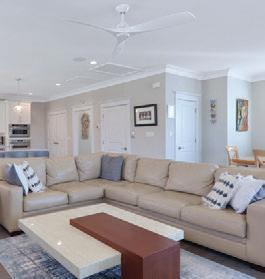








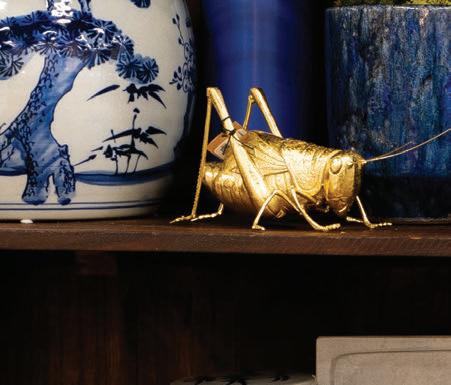













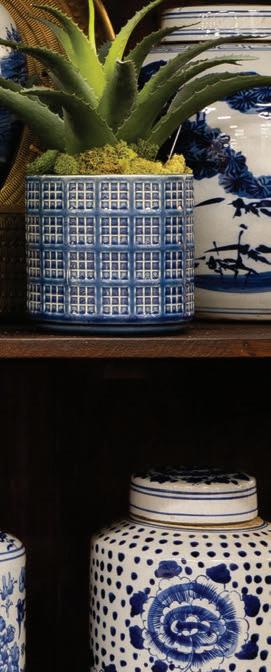






WHEN YOU RETURN TO SCHOOL at the University of Richmond School of Professional and Continuing Studies, you'll have the power to change your path. Discover your purpose. Ignite your spark. And make your mark! Build skills, expand your abilities and develop professional competencies to support your career aspirations – whether that includes a career change, growth and development or advancement. spcs.richmond.edu














30 THE INVETERATE COLLECTOR
A fresh take on traditional Southern style in the Near West End
38 THE FINISHING TOUCH
At a family river house, an art collection evolves in tandem with the decor
17 The Goods
Display your book collection with flair
18 Events
Antique and art shows, house and garden tours, and more
20 Classics
The Chinese porcelain that sparked the craze for blue-andwhite ware
22 Details
Meld your collections into your decor
24 History
A Richmond home filled with family memories
26 Design
Do’s and don’ts for displaying your prized pieces
54 Kitchen
A midcentury kitchen reimagined for a 21st-century family
56 Garden
Bonsai … you can’t have just one
58 Q&A
A young antiquarian on getting started collecting
64 Great Spaces
Travel the world via a powder room postcard collection
46 KINDRED SOULS
A 180-year-old house in Church Hill, the marvelous repository of a life filled with love

 From left: Kip Dawkins; Alexis Courtney
PHOTO BY: Gordon Gregory
ABOUT THE COVER: Susan Wynne and Je Williamson in the library of their Church Hill home
From left: Kip Dawkins; Alexis Courtney
PHOTO BY: Gordon Gregory
ABOUT THE COVER: Susan Wynne and Je Williamson in the library of their Church Hill home


PRESIDENT/PUBLISHER Richard Malkman
EDITORIAL DIRECTOR Mindy Kinsey
MANAGING EDITOR Susan W. Morgan
SENIOR EDITORS Mandy Loy, Mark Newton
COPY EDITOR-AT-LARGE Tharon Giddens
CONTRIBUTING WRITERS
Kim Catley, Paula Peters Chambers, Susan Higgins, Valerie Hubbard, Laura Anders Lee, Evan A. Morgan, Cosima Pellis, Taylor Peterson, Amanda Scudder, Olympia Theofanos, Joan Tupponce
ONLINE EDITOR Mandy Loy
R•HOME ART DIRECTOR Rachel Lee
CONTRIBUTING PHOTOGRAPHERS
Mindie Ballard, Alexis Courtney, Kip Dawkins, Gordon Gregory, Julianne Tripp Hillian, Ansel Olson, James Ransom, Tim Snyder
CONTRIBUTING ILLUSTRATOR
Ellen Surrey
CONTRIBUTING STYLISTS
Geraldine Duskin, KK Harris
SALES DIRECTOR Richard Malkman
SENIOR ACCOUNT EXECUTIVE
Martha Hebert
PRODUCTION AND OPERATIONS MANAGER Scott Bunce
SENIOR DIRECTOR OF MARKETING, SUBSCRIPTIONS AND CLIENT RELATIONS
R.J. Landin
SUBSCRIPTIONS ASSOCIATE
David Ballowe
VICE PRESIDENT/CONTROLLER Elisa Malkman
EDITORIAL & ADVERTISING OFFICES 1910 Byrd Ave., Suite 100,
MAILING ADDRESS
TELEPHONE 804-355-0111
MAIN FAX 804-355-5442
EDITORIAL AND ART FAX 804-355-8939




Our homes are reflections of our individuality, and I think most of us are collectors of some sort. My personal spaces are filled with a miscellany of objets d’art, antiques, paintings and sculpture that blend in an eclectic mix that’s totally me. One thing is certain: Whether you gravitate toward a massive display of objects or a carefully curated presentation, the collections you assemble speak volumes about your personal perspective.
What comes first, the collection or the decor? In this issue, we visit collectors to explore the ways in which the things they love in multiples influence or are influenced by their design aesthetic.
Ashley Hanley says she’s been a collector for as long as she can remember. Well known for her fresh, traditional Southern-style interiors, Hanley designed her own home in the Near West End with a classicist’s aesthetic. Valerie Hubbard takes us on a tour on Page 30.
Susan Wynne and Je Williamson (and their pup, Ripley) inhabit a wonderful old house in Church Hill that’s filled with contemporary paintings and sculpture, family antiques, and other pieces they’ve collected over time. Step inside on Page 46.
Sometimes, collections come into being as a complement to the interior design of a space. On Page 38, Kim Catley talks with Amanda Nisbett about a family retreat by the Rappahannock River that Nisbett recently designed and the contemporary art collection she curated that adds the finishing touch.
In this issue on Page 20, we explore the history of Canton porcelain, which kicked o the craze for collecting blue-and-white chinese porcelain in the 1750s. On Page 24, we visit a 1923 Byrd Park Tudor Revival-style home appointed with furniture, paintings and accessories lovingly used and handed down through the homeowner’s family for more than 125 years. We talk about some of the do’s and don’ts for displaying collections on Page 22; tour a midcentury kitchen on Page 54, newly reimagined for a 21st-century family and their treasured collections; consider the art of shaping and collecting bonsai trees on Page 56; and check out an inventive way to display a collection of more than 600 postcards on Page 64.
HOPE YOU ENJOY
THE BEAUTY SPRING BRINGS, Susan W. MorganFind us at R•Home magazine on Facebook and @rhomemag on Instagram.


CHECK OUT R•HOME ON CBS 6 DURING ‘ VIRGINIA THIS MORNING’!
Tune in for our home and garden tips on the following Wednesdays: May 8 and June 12 and 26.

ONLINE, ALL THE TIME Find beautiful photos of local homes, expert design tips and advice, and much more at rhomemag.com.
On Page 74 of the Readers’ Favorites feature in our Mar-Apr issue, Arbogast Tree & Stump was misspelled; on Page 78 in the same feature, Inspired Home Interiors was incorrectly listed as Inspired Home.














































ARTHUR’S ELECTRIC SERVICE at 8910 Brook Rd. is your one-stop shop for all your outdoor power equipment needs Celebrating 101 years – 1923-2024



• Quality brands:Toro, Stihl, Scag, Echo, Snapper,Little Wonder, Billy Goatand Mantis, andthe engine lines associated with these manufacturers
• Parts and service for the productssold
• Factory trained technicians
• Knowledgeable personnel (over 100 years of combined experience)
• Free delivery of new mowers/tractors within a 25 mile radius
• Warranty registration of equipment purchased

• Financing available on select equipment to qualified buyers










(March-Nov.)

Valerie Hubbard
Richmond native Valerie Hubbard started out as a reporter for the Richmond TimesDispatch but switched to freelance writing for Virginia magazines about 20 years ago, covering everything from Chesapeake Bay oysters and Virginia gardens to architecture and weddings. On Page 30 of this issue, she uncovers the power of collections in the hands of Richmond decorator Ashley Hanley.






Fulton Mortgage Company is your source for great financin options and competitive rates – whether you’re looking to build a new home or renovate your existing home.
• Up to 95% Construction to Perm and 90% Renovation/Rehab Loans, single close and no points!!!
• 30 Year Fixed Jumbo CP’s locked upfront with no long term lock fees While other lenders have restricted or discontinued Construction and Jumbo loans, Fulton is still lending on all products!
• No money down, No PMI Medical Professional Loans
• Jumbo purchases, Refinances and Construction Perm loans all still available!
If you’re not talking to Buzz you’re spending too much money!

Laura Anders Lee
After getting a communications degree at the University of Alabama, Laura Anders Lee has lived and worked all over the Southeast, making a home in six states and renovating three kitchens. She’s happy to be settled in Richmond with her husband, two boys and goldendoodle. A regular contributor to Richmond magazine, she loves meeting new people and covering a range of topics. In this issue, she writes about a family’s kitchen refresh in North Chesterfield on Page 54.


Whether buying, building or refinancing, let Buzz put his 25 years of lending experience to work for you.



Jay Paul bought his first camera when he was in high school, and the next year he was working for his local paper in Prince William County. When he’s not taking photos as senior photographer for R•Home and Richmond magazine, he’s working on his garden. Paul’s photos have also been seen in The New York Times, The Washington Post, Los Angeles Times, The Wall Street Journal and Rolling Stone. He photographed the postcard collection featured on Page 64.

Ellen Surrey
Ellen Surrey is an illustrator out of sunny Los Angeles. Blending her love of midcentury design and vintage children’s books, she enjoys finding beauty in the past and sharing it colorfully with a contemporary audience. Her work has appeared in The New York Times, Los Angeles Times and most recently on USPS postage stamps. Surrey’s illustrations enliven “Curate and Captivate” on Page 26.













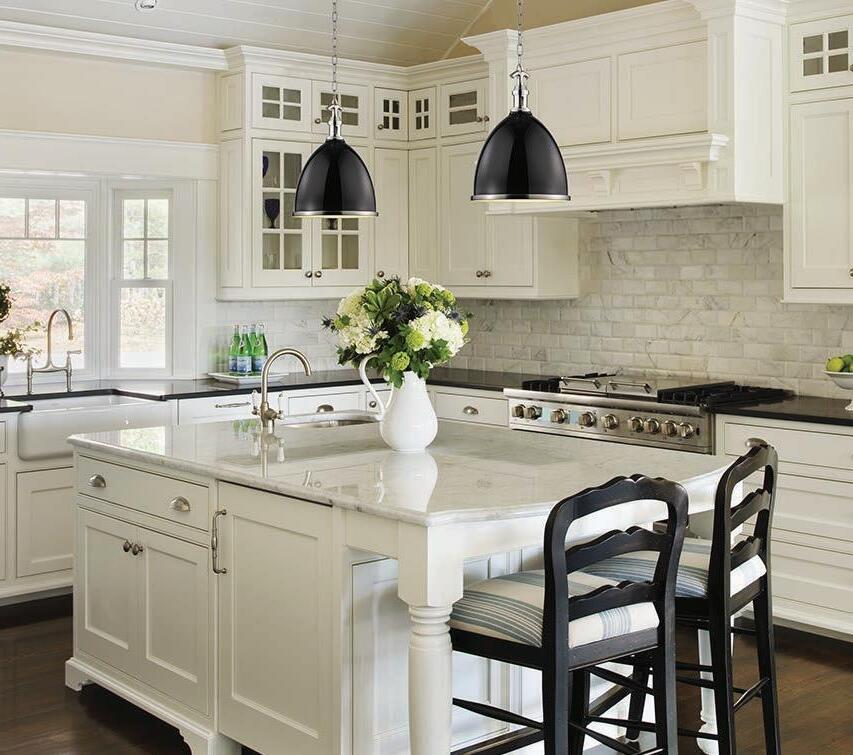















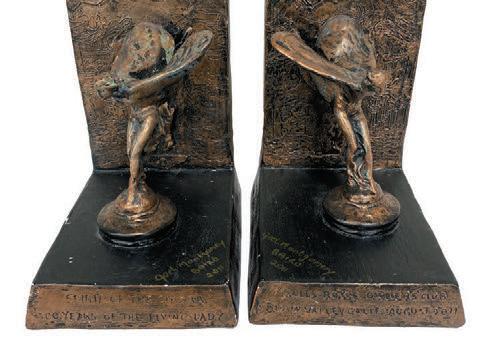
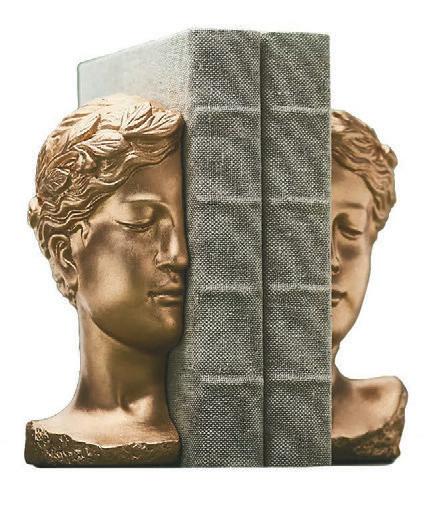




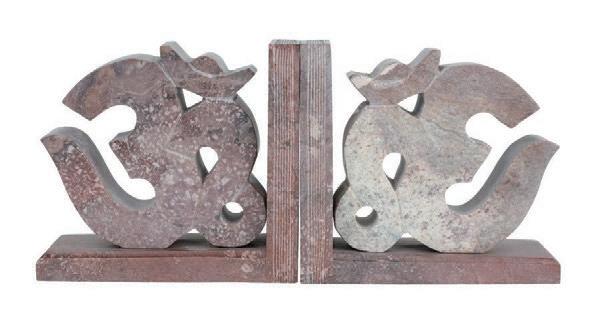




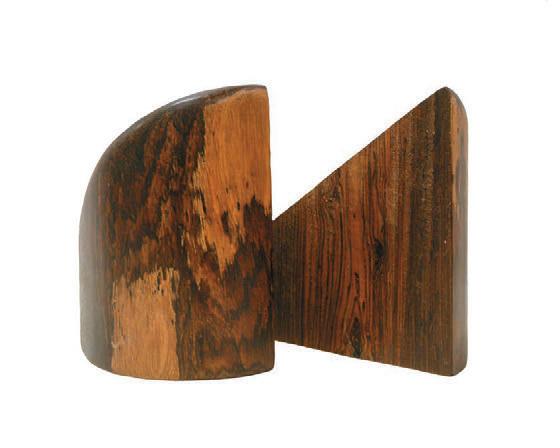

May 3-4 Lewis Ginter
Spring Plant Sale
Shop with more than 40 vendors selling plants ranging from well-known favorites to rare exotics and other garden-related items. Presented by garden volunteers. 9 a.m. to 3 p.m. each day. Free. lewisginter.org
May 3-5 Antiques At The Tavern
Historic Hanover Tavern hosts 20 hand-selected dealers o ering a variety of period furniture, ceramics, silver, pottery, jewelry, art, books, linens, folk art and more. David Williams will give a lecture at 5:30 p.m. May 4 on “Red Mulberry Southern Furniture & Recent Discoveries.” Admission is $12 to $35 per person. hanovertavern.org
May 4-5 Arts in the Park
Arts in the Park showcases more than 350 exhibitors from around the
country selling paintings, pottery and ceramics, jewelry, furniture, photography, woodworking, glass, metal, sculpture, textiles, yard art, and more. The nationally rated juried show is free at The Carillon in Byrd Park. richmond artsinthepark.com
May 5 West Avenue Garden Tour
Celebrate spring on a self-guided walking tour of the gardens of West Avenue, Park Avenue and Franklin Street in the Fan. The event features live music, children’s activities and refreshments. Noon to 5 p.m. (Children’s Parade at noon — Rear Gardens open at 1 p.m.) Free. westave.org/garden-tour
May 10-11 FURTHER AFIELD
Fishersville Antiques Expo
This seminannual event draws hundreds of vendors and thousands of customers. The 72nd edition of the
Discover local artists, music and more at the annual Fan Arts Stroll, May 16 & 17.
show o ers classic 18th- and 19thcentury American and English period antiques, vintage Americana, jewelry, silver, glassware, primitives, rugs, midcentury modern pieces, and other eclectic collectibles and hard-to-find pieces. 9 a.m. to 5 p.m. Friday and 9 a.m. to 4 p.m. Sunday. Admission is $10 per person on Friday (early shopping and two-day pass) and $5 per person on Saturday. heritagepromotions.net
May 12 Museum District Mother’s Day House & Garden Tour
Explore some of Richmond’s most beautiful and historic homes, gardens and institutions in the Museum District while you celebrate Mother’s Day. Advance tickets cost $25 at museum district.org. Pick up will call tickets or purchase day-of tickets for $30 at the Virginia Museum of History & Culture. Trolleys run a continuous loop from the VMHC parking lot along the tour route. 1 to 6 p.m. museumdistrict.org
May 16-17 Fan Arts Stroll
Stroll along Hanover and Grove avenues in the historic Fan District, where you’ll find over 120 local artists and vendors along with musicians and a bevy of food trucks. 4 to 8 p.m. Free. fandistrict.org
June 6 Flowers After 5
Listen to the syncopated sounds of “alternafolkrock” group WKNDR covering the songs of Fleetwood Mac, Wilco and others. Lewis Ginter Botanical Garden. 5 to 8 p.m. Included with regular garden admission. lewisginter.org


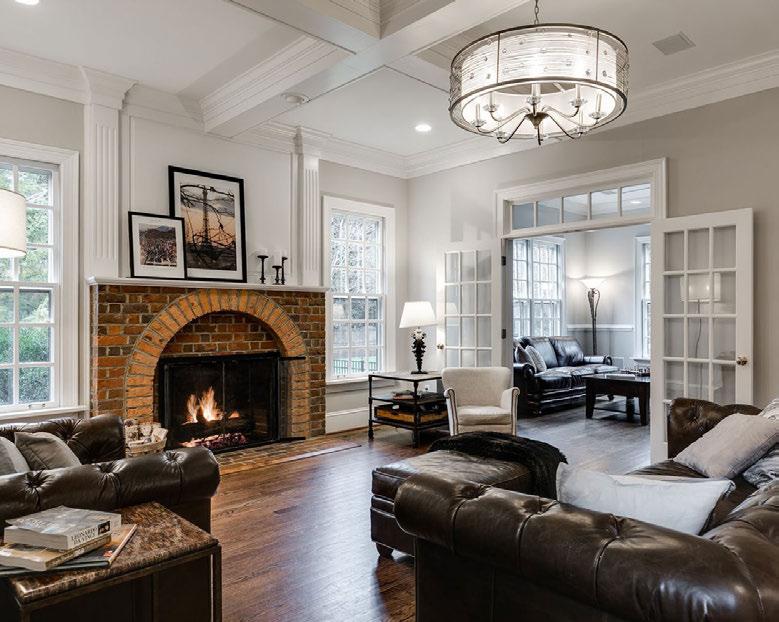





From the most fashionable tables in early America to today, the appeal of Canton porcelain endures
By Evan A. Morgan
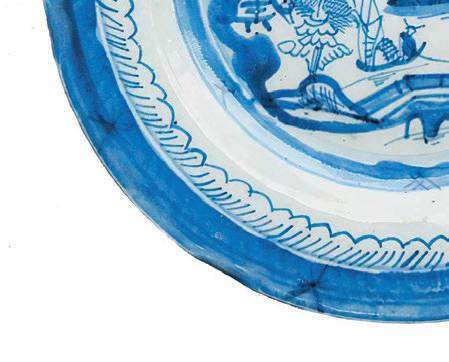


COLLECTIONS OF porcelain and stoneware have been a constant in homes for centuries.
They’re often passed down from one generation to another, added to by some, with a few pieces lost or broken over the years by others. Each family’s collection is unique and personal, varying in contents, and ever-changing. One of the most recognized porcelain patterns found in American and European homes alike is Canton ware.
Produced a few miles west of its namesake, Canton (now Guangzhou), China, Canton ware is beautifully glazed, durable porcelain that features a classic blue-and-white color scheme

with a decorative border encasing traditional landscapes dotted with tea houses and trees. This design became wildly popular as the Western world’s infatuation with the “exotic” East reached its height in the late 18th century. Not only was the pattern in vogue, it was much cheaper to produce and acquire than hand-painted European porcelain while also proving much more durable.
Consequently, European merchants began exporting Canton ware en masse to Western countries in the 1750s. (A fun fact: Due to its strong nature, crates of Canton ware were often used as ballast on the very ships that transported them, stabilizing the vessels while serv-
ing as a platform to keep more precious items out of harm’s way.) By the 1790s, America was the largest importer of Chinese porcelain, which the middle class had adopted as a status symbol. George and Martha Washington owned several pieces of Canton china that can still be viewed at Mount Vernon today. Adoration was so widespread that in 1779 an English transferware producer named Thomas Turner decided to mimic its style in one of his own designs called Blue Willow. Turner was clearly ahead of the curve, as the lower price points of transferware propelled its demand far beyond that of Canton ware. Amid transferware’s rise, the




The elegantly simple design and enduring quality of Canton ware made it an iconic set of serveware that has withstood the test of time.




Americans at the turn of the 19th century considered Canton ware’s centuries-old Chinese landscape scenes exotic and decorative, the height of chic.
accessibility to Canton ware became scarce to none as trade relations with China ceased during the Opium Wars. By the time trade resumed in 1860, the fervor for Canton ware had waned, though it was already firmly entrenched in the collections of many American and European families, where it has remained ever since.

Encapsulating the original essence of Canton ware, Mottahedeh has created a perfect reproduction that would feel right at home alongside its antique counterparts. Made under license of the Historic Charleston Foundation for more than 40 years. Available through Hampton House , hamptonhousegifts. com, 308 Libbie Ave.
The elegantly simple design and


Dana Gibson has created a new style of Canton by combining elements from the original pattern such as the color scheme and imagery depicted with her unique perspective, manipulating color and negative space to give the design new life. danagibson.com
enduring quality of Canton ware made it an iconic example of serveware that has withstood the test of time. For those looking to expand their collections or replace lost pieces, one can find antique, vintage and reproduction Canton ware at local antique and vintage shops, or online at Chairish, eBay, Replacements or Etsy.


A fresh take on the idea of Canton, Ginori 1735’s Oriente Italiano collection started with a similar pattern of a quaint garden surrounded by a delicate border of blossoms and infused it with bright, modern shades of pinks, purples and greens that will stand out on any dinner table. Available through Fraîche Home, fraichehome.com, 5805 Grove Ave.

Most of us spend a lot of time in our homes, but are they truly reflections of who we are?
Many things make up our essence — personal history, jobs, hobbies, interests. One way we showcase these pieces of ourselves is through our collections, which highlight the things we are most passionate about and o er a unique window into our personality.
However, collections needn’t be limited to expensive, one-of-a-kind pieces or overabundant knickknacks. They can be anything from decorative pieces to more functional items that evoke the spirit of the collector. When done strategically, incorporating collections into your home decor is a great way to authentically weave your personality into a space.
Homeowner Mary Beth Scott was introduced to McCoy pottery by her father, who began collecting it as a memory of the pieces seen in his childhood home. “[My parents] taught me how to find the character in some of these older pieces and make them my own in today's age,” Scott says.
Now, Scott is fully engrossed in the thrill of the hunt, trying to find pieces to add to her collection with her father. In addition to McCoy pottery, Scott also collects Fenton Art Glass, of which her mother was an avid fan, and figurines made in occupied Japan, which is a col-
lection she’s taken up for herself.
As she decorated her home, Scott says, her rule was to incorporate at least one piece from one of her collections in each room. “I'll start with a piece from my collection and then [design] the room from it or go from a fabric that I just had to have and choose the perfect piece to go with it,” she says.
In her basement, Scott worked with SMS Architects on a custom built-in bookshelf inspired by the octagonal paneling found in her home’s original door, designed over 100 years ago. Nestled between traditional shelves storing books are octagonal cutouts that frame a selection of McCoy pottery pieces, including several that Scott hunted specifically for the bookshelf as it was being built.
Sometimes the collections themselves influence the design elements incorporated into a space, explains Stephanie Theofanos, founder of Modern Traditions Interior Design. Recalling a recent project where she helped a Richmond couple who collected work by local artists find decor that complemented but
did not overpower their art collection.
“One of the art pieces featured a very strong orange,” Theofanos says, “so we did accent pillows in a deep orange and later found a [crinkled glass sculpture] for the co ee table.”
For Theofanos, finding themes, whether through colors, shapes or other elements, is a great way to incorporate a common thread throughout your home decor without taking away from the pieces themselves.
For larger collections, Theofanos says it’s also helpful to group small items and rotate items seasonally to reduce busyness and keep the home visually exciting. “Grouping them together makes more of a statement and makes it easier to stop and take in.”






Collected over the generations, cherished family furniture, paintings and objets d’art create a unique aesthetic


AS A CHILD, Ellen LeCompte would often seek out her great-great-great-grandmother Rebecca Barnes for comfort.
“I’d go into the parlor and talk with her,” LeCompte says. “If I was unhappy, she was unhappy. She was always sympathetic.”
You see, “triple-great” Grandmother Rebecca — as LeCompte refers to her ancestor — was available to her via a portrait, which hung in her childhood residence. Now, the painting is one of many family pieces LeCompte and her husband, Pettus, happily display in their Byrd Park home.
“It’s important for families to be stewards” of history, LeCompte says, noting that an 1830s desk originally from her ancestor’s Philadelphia house was a repository for many generations of family members. When she began exploring its contents, she found “archaeological layers” ranging from a power of attorney declaration from 1688, deeds written on sheepskin from 1720 and a receipt from the mid-19th century for a great-grandfather’s Marine uniform. “It wasn’t important then, in 1858 — just a receipt,” she says, “but it’s very helpful now, to have these mundane things.”
PAINTING
A favorite portrait of triple-greatgrandmother Rebecca Barnes with two of her grandchildren, Mary and Edward. All of the furniture in the circa 1840 painting by the American artist Cameron is still in use in the LeComptes' Byrd Park home.
FANS
A collection of 18thcentury British-made fans and 19th-century ladies' accessories acquired and used by Ellen's ancestors
CHINA
The family still uses a double dinner service made by John Ridgway & Co. in Sta ordshire, England, in the 1840s for large parties and holiday dinners today.
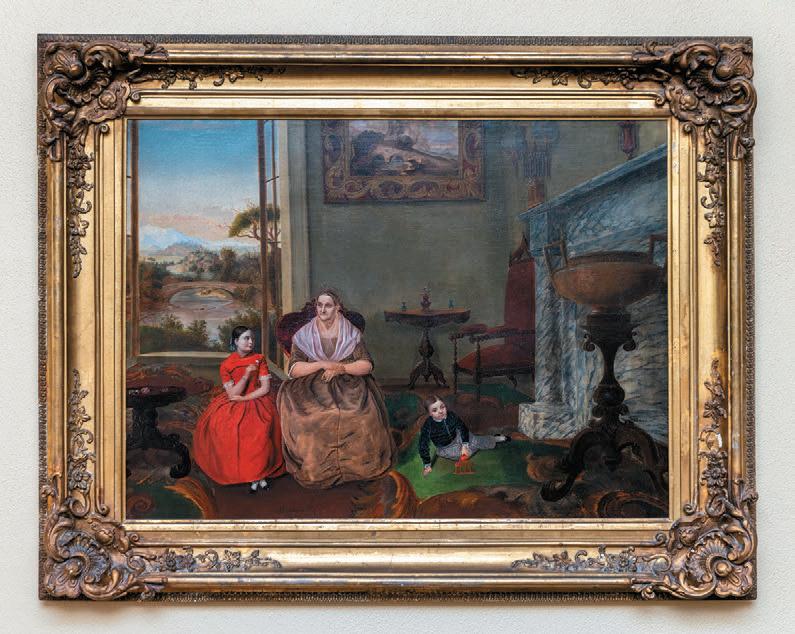
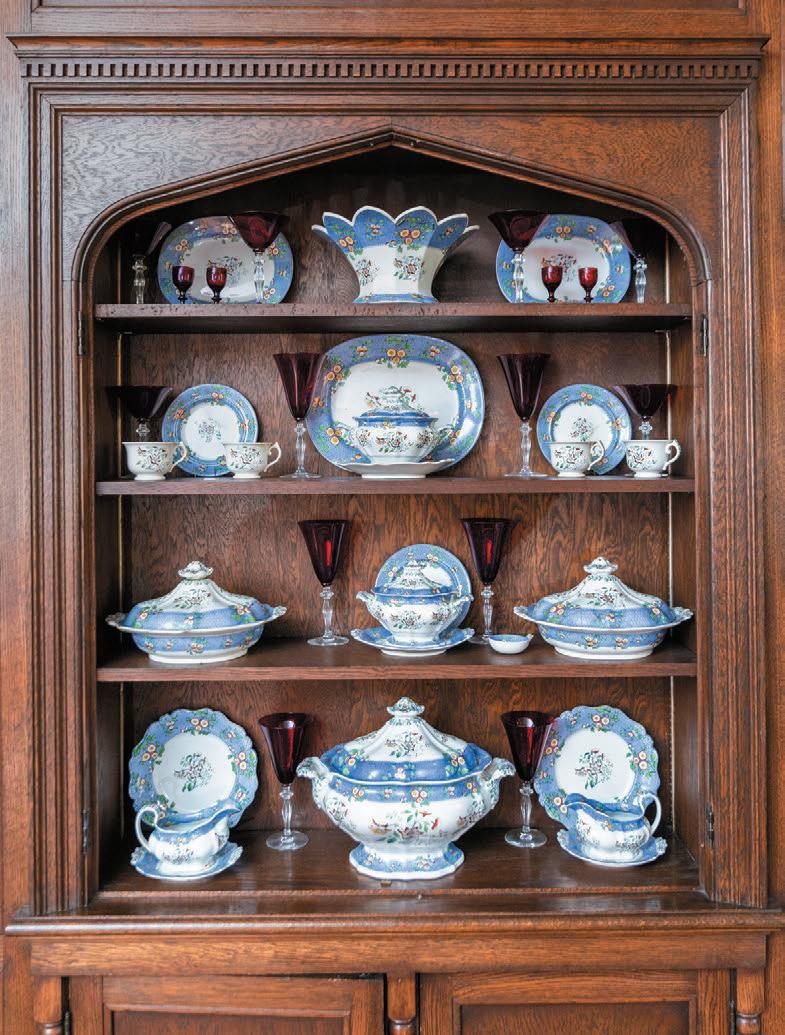

Fortunately, the LeComptes have space for family heirlooms. Their home, a Tudor Revival built in 1923, has more than 6,000 square feet over three floors and was owned for 40 years by Pettus’ grandparents. After purchasing the house from his grandparents’ estate, Ellen and Pettus began updating it while incorporating items gathered via the family tree.
“Things fell into place,” LeCompte says, noting that the house needed no structural work but plenty of system updates: plumbing, electrical and security. “We redid the 1929 kitchen, keeping the original tile where we could. And,” she adds, “we kept the bathrooms, even though we had to fight the plumbers over that, because there aren’t access panels [to the pipes]. And we had a painter here for six months.”
Using colors found in the existing living room rug, a 20-foot-by-11 3/4-foot Persian carpet dating to 1920, LeCompte worked with a friend to create a warm and welcoming living environment. “I spend a lot of time in the United Kingdom with very fun friends and very fun houses,” she says. “English country houses are all very comfortable, and they use what they have.”
Over the years, LeCompte made decisions about how to best use what she had. She relocated two parlor settees from the living room and purchased new sofas that o er comfortable seating for her regular afternoon tea with friends. A circular glass-topped table might not be antique, but it’s good for tea spills, and its wood base with ball-and-claw feet is in keeping with other furniture in the room. Porcelain vases her great-grandfather Lucien LeCompte Dawson (Ellen and Pettus share a common distant ancestor) brought back from Hong Kong have been made into lamps, despite what antiques experts might recommend for authenticity. And Gilded Age lamps are missing dangling prisms, removed so they would nestle easily against a wall.
“It’s all here together and very eclectic, but it works,” LeCompte says. “These are treasures that connect us with our family heritage. Having these things is important.”
Collections are museums of the soul. Each object reflects a cherished memory or exciting acquisition. Beyond furniture and fabric, the heart of a Richmond home lies in the things that hold meaning for the people within.
Collecting is intrinsic to the human experience. Pretty shells and pebbles held the same allure for our Stone Age ancestors as they do for us today. Victorians, with a magpie’s eye for novel trinkets, were consummate collectors. Their cabinets of curiosities overflowed with botanical specimens, delicate bones and iridescent butterfly wings. Souvenirs, postcards, stamps and coins were meaningful mementos then and remain so now.
The components of an interesting collection are boundless. Anything that is significant to the collector can become a defining design element, infusing a home with endless character. The only wrong way to display a collection is carelessly, so it merits some thought about what to showcase, where and how.
CONTEXTUALIZE … OR NOT
Display collections in spaces that make sense. Framed album covers cozy up nicely in a den while a set of antique rolling pins gives o kitchen vibes. But sometimes rules are made to be broken. Things displayed out of context can be enchanting. A powder room wallpapered in postcards sparks curiosity, while a collage of vintage buttons is as cute as a button in a nursery.
Richmond is home to a wealth of history and culture that inspire collectors and collections of all kinds. As the spaces celebrated in this issue make clear, with creativity, it’s fun to transform collectibles into captivating narratives for your home.


CURATE
When incorporating a collection into your design, start by selecting what will take center stage. Choose your absolute favorites and group them by theme, color or texture to tell a cohesive story. Be bold! Hold some things back and rotate them seasonally or as the mood strikes.
Frames focus the eye and elevate the importance of what lies within. Frame collections vertically using shadow boxes or floating shelves or horizontally using a tray. This creates a bigger visual impact, especially for smaller pieces, and it communicates intentional composition rather than unintended clutter. The space surrounding a display is also important, so leave room for the eye to rest.
Make your collection sing by using rhythm in color, pattern and size. Groupings in odd numbers create balance. Within a triad, a small, medium and large item each satisfy the desire for order and variety. Experiment with risers or other bases to create depth and height for dynamic compositions. For colorful collections, rainbow order is pleasantly prismatic, though monochromatic groupings are equally impactful.
Choose a contrasting backdrop, be it paint or wallpaper, to make your collection pop. Directing light onto a display also creates drama and amps up allure. There are many easily installed fixtures available to illuminate shelves, pedestals and walls.




















The custom window treatments are in a Pierre Frey fabric, the vintage co ee table was custom lacquered by H.J. Holtz & Son, the walls and trim are painted Sherwin-Williams Greek Villa, the artwork is vintage and the pillows on the antique sofa were made from vintage cross-stitch panels and Brunschwig & Fils “Les Touches” fabric.


It started with rocks and leaves and then turned into stamps and postcards,
recalls Ashley Hanley, whose childhood treasures gradually grew to include maps, comic books and di erent sorts of “trinket-y” souvenirs from family trips. “I’ve always been a collector,” says Hanley.
Now, at the helm of her eponymous interior design firm, Hanley has embraced the art of collecting as a jumping-o point for creating living spaces that weave together treasured pieces with modern family style. Her personal collections, which can be seen layered throughout the Near West End home she shares with her husband, Brendan, and their young daughters, Frances Miller and Louise, showcase the important role these beloved items play in her decorating.
A native of Richmond, Hanley went to Virginia Tech to study fashion design, which she quickly realized wasn’t the best path for
her. “Instead, I dove into interior design,” she says. It began with adventures combing through antique shops, thrift stores and even retailers like such as HomeGoods and T.J. Maxx. She found herself gravitating toward anything blue and white. After college, she interned with designer Marcie Blough and worked at Ruth & Ollie (a now-shuttered popular home furnishings shop in Carytown), before opening her own firm in 2017.
Today, Hanley is focused on finding just the right blend. “I love fine antiques, and I love wicker and rattan, more casual pieces, and I think it's OK to mix those types of pieces together and display things you love,” she says. Her latest obsession is wood inlay boxes. Her collections are wide ranging, encompassing everything from equestrian hunt and botanical prints to vintage fine

The chandelier is an antique Hanley discovered at a Philadelphia auction house, the drapery panels are vintage Colefax & Fowler purchased from The Pink Door, the Henredon dining table and Chippendale style dining chairs, and the artworks are vintage.
Custom sofas are upholstered in a Kravet Crypton velvet; custom throw pillows are made from Schumacher, Pierre Frey and Scalamandre fabrics; the custom ottoman is by TCS Designs; the floor lamp is by Visual Comfort; and the blue-and-white end table lamp is by Bunny Williams.
jewelry, silver trays and bags. She also has an a nity for cheeky needlepoint pillows.
“Blue has always been my favorite color,” she says. “And, growing up, my mother was a collector of blue-and-white pieces, and my grandmother had some beautiful blue-andwhite china, so I just kind of naturally had an inclination towards those pieces. It was what I was always surrounded with.”
A wide variety of Chinese export-style blue-and-white porcelain pieces are found throughout Hanley’s home, blending e ortlessly with a mix of antiques and modern elements that together create her signature “new Southern traditional style” that is both timeless and of the moment.
Like the blue-and-white accessories featured prominently throughout her home’s interiors, the majority of Hanley’s pieces are rooted in childhood nostalgia, including art and furnishings that evoke another era; such as antiques, heirlooms and secondhand pieces that have been passed down over time.
To build her own collections, as well as for clients, Hanley frequents local antique and specialty shops in Richmond as well as Charleston, South Carolina, one of her favorite destinations. In Richmond, her current go-to

spot is Justin Westbrook Antiques, where she says she has scored some terrific finds.
Hanley’s design process involves plenty of trial and error. She constantly looks for ways to have collections of accessories match their surroundings. “The accessories get moved around a lot. As I find designated homes for them, I play around with di erent options for them as I mix them in with the furnishings,” she says.
It is important that the collections accentuate the furnishings and that they remain in concert, says Hanley. Just as the furnishings are a variety of sizes and shapes, so are the



READING NOOK
A quiet, cozy spot in the playroom that doubles as a guest bed. The walls are clad in Sister Parish Serendipity wallpaper, the custom window treatments are Quadrille Les Indiennes, toss pillows are covered in Lee Jofa and Brunschwig & Fils fabrics, and the needlepoint pillow is vintage.

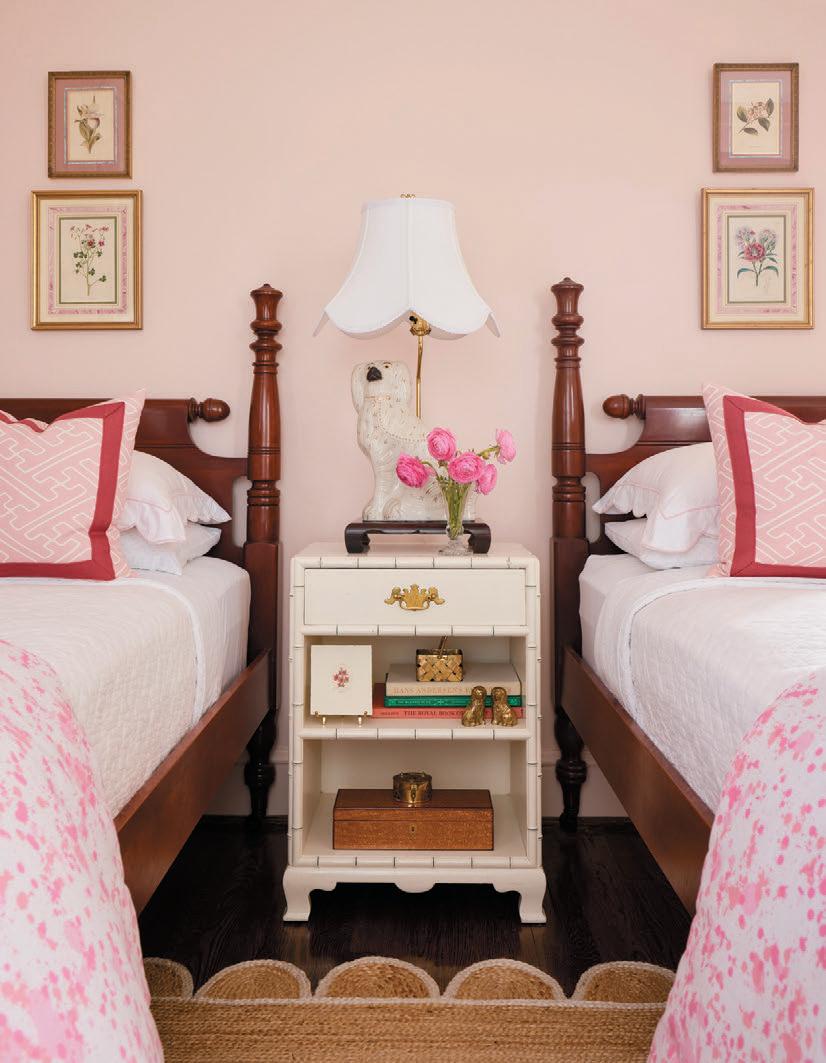
The vintage furnishings in daughter Louise’s room include a bed that belonged to Hanley’s mother when she was a girl. The bedding is a mix of high and low gathered from Target, Lands' End, Garnet Hill and Biscuit Home and a neckroll pillow in a Sister Parish fabric.
A pair of vintage twin-size poster beds and bedside table in daughter Frances Miller’s room find symmetry with a selection of antique botanical prints from Hanley’s collection. Hanley assembled the lamp herself by attaching an antique Sta ordshire dog to a base she found and adding a shade from Shades of Light.
items in her collections. The trick is to layer them in. She likes to place larger pieces on larger furnishings. Medium pieces may go on a hutch or similar piece of furniture, with smaller pieces on co ee tables and end tables.
While Hanley will occasionally purge some of her older reproduction pieces and sell them o , there are pieces she will never part with, including delicate mini jars and a miniature jug on display in her living room. A uniquely shaped bowl is one of her alltime favorites.
“I help clients open their eyes to possibilities as they build a collection,” she says. “It’s fun to start a collection for a client and then watch them embrace it and expand on it. I like to base client collections on their special interests, whether it be travel, gardening, architecture or something else.”
Hanley says her work has evolved, becoming more layered, refined and elevated over time.
Displaying a mix of collections and furnishings brings a timeless feel to any home. Though Hanley admits she currently has a trove of items in her basement that she has acquired over time, all just waiting for the right home, the right mix and exact right spot to be put on display, cherished and admired, she muses, “Whatever you collect, what good is it if it’s stashed in a drawer or hidden away in a box?”
Whatever you collect, what good is it if it’s stashed in a drawer or hidden away in a box?”
—ASHLEY HANLEY

Farrow & Ball Parma Gray paint on the walls provides a soft background for the vintage paintings and chinoiserie screen from Hanley’s collection. The lamp is by Wisteria, the table by Ballard Design. The antique four-poster bed is dressed in a mix of low and high, new and antique bedding.
At a family river house, an art collection evolves in tandem with the interiors

Designed to be lived in: The custom 11-by16-foot sofa is upholstered in a Pierre Frey performance fabric, and the Verellen swivel chairs are in a sturdy navy blue Manuel Canovas linen. Layered lighting includes Saladino table lamps and Vaughn Designs up-light lamps. The walls are painted a bright white, and the ceiling is finished with faux bois pattern wallpaper installed by H.J. Holtz and Son.
story by KIM CATLEY photos by GORDON GREGORY
When Amanda Nisbet set out to design her clients’ river house in Weems on the Northern Neck, the mandate was simple: Keep it calm and inviting, a place where the family of five can be cozy and relax with their friends.
Nisbet drew her initial inspiration from the home’s setting and an expansive window overlooking the Rappahannock River.
“It’s all about the view when you walk in,” she says. “I didn’t want to have a jarring transition. When you have a big, open window with such a lovely view, you have to bring the outside to the inside.”
Taking that into consideration, Nisbet developed a color palette for the main floor that balanced the clean, crisp gray her cli-
ents loved with navy and green to reflect the outdoors. Upstairs, pops of orange, lilac and pink add visual interest and a touch of femininity.
In the living room, Nisbet opted for a navy, white and green color palette and a mix of geometric patterns and natural textures. An oversized custom sectional upholstered in navy-and-white fabric from Pierre Frey is balanced by a wingback chair from Verellen in a durable navy mohair fabric. Custom pillows in variety of fabrics and trim from Zak+Fox, Pierre Frey, Cowtan & Tout, and Samuel & Sons add vibrant green and white accents, while an oak side table from the clients’ collection and drinks table from CB2 bring in natural elements.
As the project continued and Nisbet developed a deeper relationship with
the clients, she gained their trust and introduced more patterns and colors. In the dining room, a table and chairs from Serena and Lily o er a continuity of navy, white and natural materials. However, Nisbet accented the space with a boldly patterned navy-and-white wallpaper, “Lyford Trellis” from Quadrille.
“She wanted simple and clean. She didn’t want patterns or flowers, nothing overtly colorful,” Nisbet says of her client. “Soothing was the operative word. But she also said, ‘I want to be pushed.’”
Custom curtains by Inaray in a thick white fabric have a patterned fabric trim. The cerused oak and white sconces are by Urban Electric, and the blue lacquered octagonal mirror is by Oomph Home.


ENTRY
Lacquered raffia wallpaper by Phillip Jeffries provides a crisp canvas for paintings by Patricia Udell. The carpet is by Stark, the clients’ Chinese Chippendale-style chair was given a custom cushion, and the bobbin console table is by Chelsea Textiles.

MEDIA ROOM
In this space designed for TV viewing and gaming with durable and hardy fabrics and furnishings, the walls are covered with a vinyl sisal wallpaper. The tangerine- and cayenne-colored toss pillows are covered in boiled wool and linen fabrics. The felted ottomans have removable metal tray tops, and the swivel tub chairs are upholstered in a Schumacher fabric.

pieces that aligned with the owners’ minimalist style yet were unique to their home.
Artwork also became a crucial element of the project. While the owners have artwork in their primary home, they had little to bring to the vacation property. Nisbet was tasked with building a collection in tandem with the design she was creating.
“This was my first time working with this client, so there was a level of trust that always has to be earned,” she says. “Once the upholstery and other pieces started coming in, they said they would like me to do the art, as well.”
Since the interior design was well established, Nisbet’s challenge was finding art that fit the existing aesthetic without feeling overly coordinated. She also wanted to find
Nisbet focused on prints and paintings that added color to the spaces without being overly edgy and that evoked a sense of fun and calm. After 30 years in the industry, she says, she has developed relationships with a bevy of galleries, including Quogue and Voltz Clarke in New York, that represent a range of reputable artists. She also regularly attends art shows such as Art Basel in Miami and The Armory Show and IFPDA Print Fair in New York City.
“I keep my eye open to find new artists, to find things that are a ordable but interesting and unique,” she says, “just like I’m always looking for unusual fabrics or an unusual piece of furniture or lighting that makes a space unique. It’s a part of my job that I love doing.”
For the main stairway, just inside the entrance, she turned to artist Patricia Udell
from the Quogue Gallery, who had a series of geographic gouache paintings — “Indigo Figurative” and “Figurative Squiggle” — that set a welcoming tone for the rest of the home. According to Nisbet, the oversized paintings also created a sense of scale in a space with high ceilings without filling the wall with a “cacophony” of smaller artworks.
The artwork also helped to define two spaces upstairs: the primary bedroom, which featured a softer palette of lilac and pink, and a game room where the owners’ sons hang out with their friends. The game room, which also includes a navy sectional with bright red throw pillows, features a series of 26 paintings by Susan Currie that evoke a subtle nautical feel. And in the primary bedroom, Nisbet selected “Sunday Breezes,” a pink-and-orange ombre painting by David Michael Slonim of the Quogue Gallery, to add a bit of femininity for the only woman in the house.

A softer color palette and tactile textured layers — such as the lilac chevron curtains and matching Roman shades, pink swivel chair and leather ottoman, cane headboard and nightstands, and a pair of scalloped mirrors with a lacquer finish — add a more feminine flair.
Designed for use as a home office — and a great place to do puzzles — the sunroom features a pendant lantern by Coleen and Company and a white lacquer desk. The stools are braided raffia, and the toss pillows on the sofa are by Fermoie.
Nisbet says the art collection also brings a sense of cohesiveness to the home, bridging the color palette across various spaces. For instance, in the living room, an untitled trio of oil paintings by Susan Vecsey of Quogue Gallery and a commissioned pastel-and-pencil work by Maru Quiñonero of Voltz Clarke Gallery nod to the natural world outdoors while bringing the pinks and purples found upstairs down to the main floor.
“I might choose something more geometric or with di erent colors, but they all echo back to each other and to the scheme of the house,” she says. “Because the furnishings were simpler, the art was the final touch that brought it all together. It was a true joy finding the right pieces; it feels like you’ve found the last piece of the puzzle.”
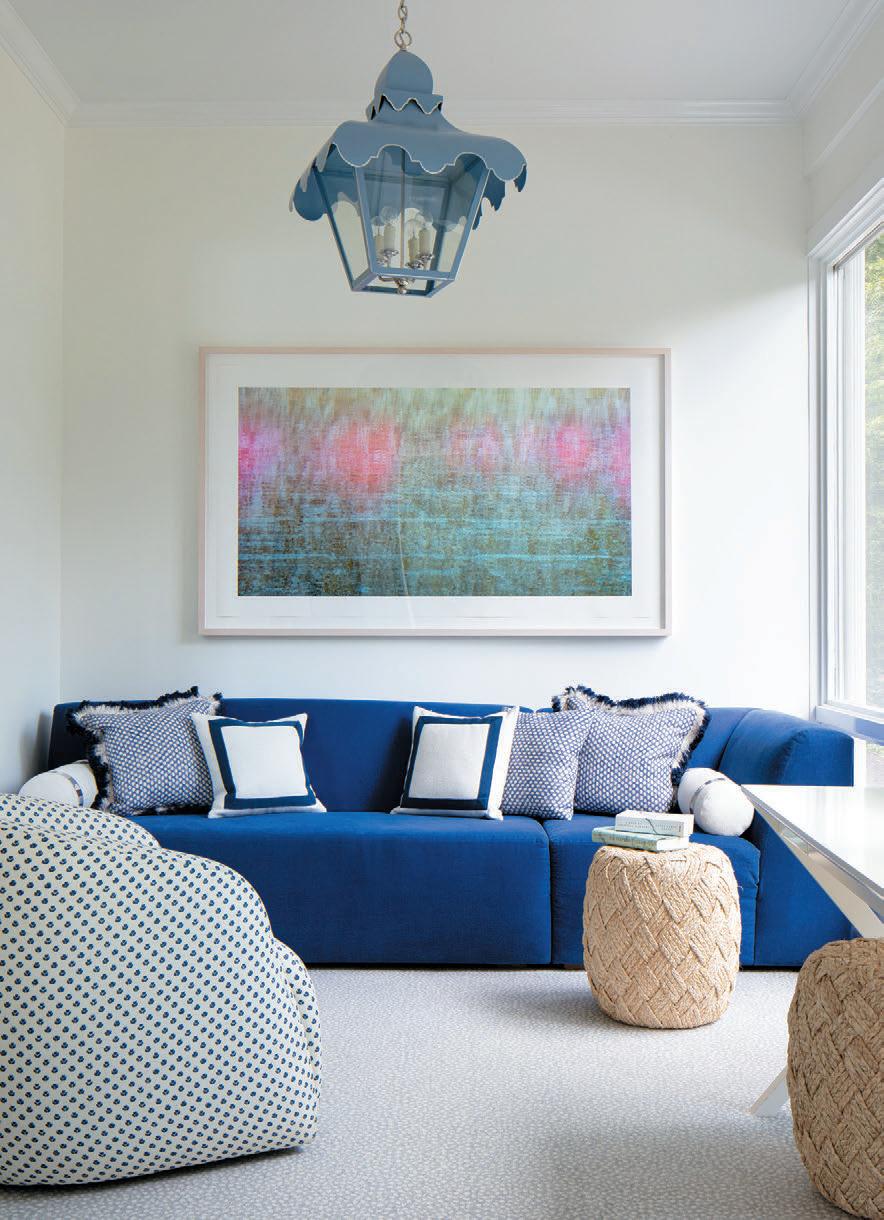

BEDROOM
Located just off the media room, this cozy guest room is enveloped in serene botanical-patterned wallpaper by Zoffany. The chrome scones are by Schoolhouse Electric.



historic home in Church Hill is a marvelous repository of a life filled with love
You might say their meeting was serendipitous. Susan Wynne and Je rey Williamson were living in St. Louis at the time. They both loved big, old houses — each owned one that they were furnishing with antiques and vintage thrift store finds — and they both loved dogs.
“It was interesting … when I met Je ,” Wynne says. “The first time I went to his house, I didn’t know what to expect going to a single man’s house. I was surprised. There were antiques. There were oriental rugs on the floor, and plants. And he’d bought all of it; his ex-wife didn’t like old stu .”
It was kismet.
“We had the most exquisite 1897 home in St. Louis. Oh, my God, everything was there. And I loved it so,” Wynne says. There the couple merged their antique and vintage collections and began adding to their decor vintage carpets and other pieces that spoke to them. They also combed the local antique and vintage shops in St. Louis and those they encountered on their travels for crystal chandeliers and sconces, antique furniture, ceramics, sterling silver, and more.
When VCU recruited Williamson to join its radiation oncology program in 2002, the couple relocated to Richmond, installing their collections in one of the historic mansions on Monument Avenue.
In 2012, they made the decision to purchase a smaller home. Wynne says she was enchanted by the Church Hill house from the moment she saw it. In addition to rooms with generous proportions, original architectural details and a large garden, the house has its own intriguing history. It is one of a pair designed by architect Otis Manson and built for the merchant John Van Lew — father of noted pro-Union Civil War spy Elizabeth Van Lew — as rental properties in 1843. Elizabeth’s brother, also named John, who assisted with her espionage, later inherited the house. There is a hidden space on the lower level, accessed through a door in the current powder room, that has generated much speculation as to what might have gone on behind its walls, Williamson says.
Warm coral colors are prominent throughout the house, where cherished family mementos and antique and vintage pieces mix with modern art and artifacts from Indigenous cultures around the world, blending in a unique harmony. The couple share a preference for American country-style Federal furniture from 1800 to 1830, described by Williamson as kind of a country estate style rather than formal furnishing. And while they had many
Family dog Ripley surveys the front hallway. The late-18thcentury grandfather clock was made for Cragfont, the house Wynne’s ancestor Gen. James Winchester built in Tennessee beginning in 1798. The paintings are by Peter Fowler and Josh George, and the antique console table was purchased at an estate sale at Richmond’s Ellen Glasgow house.
One of a pair of houses designed and built in 1843 as rental homes for John Van Lew by architect Otis Manson, one of the first architects in Virginia. Manson also designed and built Carrington Row, a row of Neoclassicalstyle homes in Church Hill, in 1818.
interesting pieces individually, together they have acquired more.
Their shared aesthetic and eclectic style are evident throughout the house. In the dining room, for example, a glass-door cupboard and sideboard Williamson purchased before meeting Wynne share space with an antique cherry corner cupboard from Wynne’s collection, an antique her grandfather purchased for Wynnewood, an 1828 log house her family called


home for almost 150 years (1834-1975) that’s now a Tennessee state historic site.
A crystal chandelier, one of many collected in St. Louis when outfitting their first house and brought with them to Richmond, hangs over the large vintage dining table. When they bought it, the crystal prisms were missing, so they found some in another shop and added them to the fixture. In Williamson’s study, the crystal chandelier and sconces are ornamented with deer antlers, keeping his taxidermied moose head trophy company. The large crystal chandelier in the living room was purchased for the dining room of their Monument Avenue home. “We were looking for something big and imposing,” Wynne says, “and we kept asking antique dealers here until somebody finally said, ‘I know a dealer who’s got one hanging in a jewelry store in Smithville.’ And we went to see it, and that was it.”
Today, the canine collection that started with a pair of foo dogs purchased in St. Louis has grown to include paintings, prints and sculptures — in bronze, papier-mache, ceramic and wood — that are displayed throughout the house. “When I first met Je , I was taken with what a dog nut he was,” Wynne says. “And


LIBRARY
Je rey Williamson, Susan Wynne and Ripley. The wing chairs are vintage, the oval spoon-foot table is an antique they found in Maine. The bronze bull sculpture is by Rubin Peacock. The painting over the mantel is by Jo Kennedy. The crystal chandelier is one they created by marrying two antiques — a wedding cake chandelier and an amber glass fixture.

LIVING ROOM
In a corner of the living room, a Chinese morning coat Wynne inherited from one of her great-aunts is displayed over a writing table that once belong to her ancestor Col. A.R. Wynne. The brass dog bookends are antique, the painted skull is from Mexico City, and the folk art dog is papier-mache.
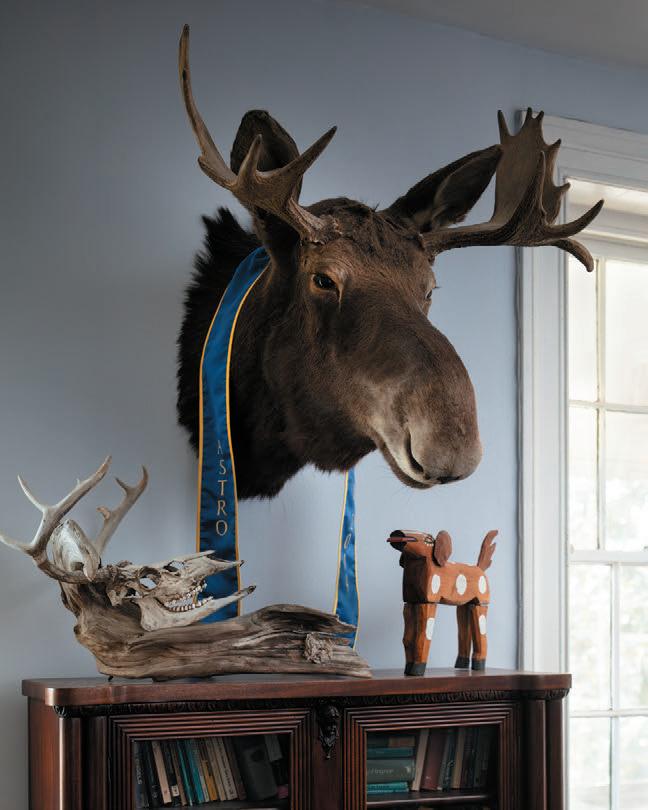
so I said to myself, ‘I’m going to start him a dog collection.’ Once I started this o , Je picked up on it. We probably have more of these [dog] bronzes than we need.”
Cherished family heirlooms such as the Chinese morning coat displayed on the living room wall enhance the eclectic interiors. Wynne says of the coat, which once belonged to a great-aunt who lived in China in the 1940s, “I only wish that I had known her when I was an adult and could ask more questions. ... She used to wear it to drink co ee and smoke cigarettes. She had a bunch of them, but I feel very happy to have this. And I used to wear it. But it’s very old and the silk is fraying, so I’ve put it on display instead.”
The taxidermied moose head in Williamson’s study is a trophy from a childhood hunting trip with his father in Canada. The moose is wearing Williamson’s honorary membership ribbon to ASTRO, the American Society of Therapeutic Radiologists and Oncologists. The late-Victorian book cabinet below was previously owned by Wynne’s great-aunt.
The couple found the drop-front English walnut desk — comprised of late-18th- and early-19th-century pieces — in a shop in Williamsburg shortly after they moved to Richmond. The desk chair is from Wynnewood.
Wynne bought the carved wooden dog on top of the desk from an African vendor on Broad Street.

The painting is by Peter Fowler. The sculpture of carved red volcanic stone finished with bronze casting is by Rubin Peacock.
The coral and cinnabar pieces were once owned by Wynne’s greataunt, and the Mezo American figure was purchased on a trip to Guadalajara, Mexico.





Meg Traynham
(c) 804.356.9045 · (o) 804.288.8888
Richmond Magazine asked more than 5,000 agents to share three REALTORS® they would recommend to a friend or family member. Meg Traynham, Lollie Shankle, and Sarah Kate Shepherd were selected among Richmond’s Most Referred REALTORS® based on their outstanding reputations and expertise in the areas of:
Market knowledge and negotiation skills
Professionalism, Customer service and integrity
The strength of the Meg Traynham Homes Team has been built on referrals, so chances are you, or someone you know, already knows them. If not, call today and become one of their many happy and satisfied clients!
Meg.Traynham@LNF.com · megsellshomes.com




Lollie Shankle
(c) 804.855.4222 Lollie.Shankle@LNF.com
Sarah Kate Shepherd
(c) 804.921.8889 sarahkate@LNF.com















An original midcentury-era kitchen in Chesterfield is reimagined for a 21st-century family’s curated collections
SUZY BROCKMANN and her husband, Ian Calder, love a DIY project. So when they found a house in North Chesterfield with its original 1949 kitchen, they couldn’t wait to dive in.
The couple shares a vintage aesthetic
By Laura Anders Lee | Photos by Alexis Courtneyand a love for unique pieces. Calder has a background in graphic design and Brockmann studied feng shui. Their home has just 1,300 square feet, so maximizing space for their growing family was important.
“We wanted to infuse beauty in the space while making it flow and be really practical in a bustling kitchen with two kids,” Brockmann says.
To get started, they called their friend Pete Guyre with PeterWerks. To
save money, Guyre used plywood for the cabinets, shelving, banquette and island. A clear coat seals the wood, giving it a shine and making it easy to wipe down. “We really love the natural look of the wood, and Pete did such a beautiful job lining up the patterns,” Brockmann says.
Calder did the electrical work, rerouted the gas line for the range and installed the cork flooring himself. On Black Friday, the couple snagged a deal on Smeg appliances, which give the kitchen a cool, retro feel.
The countertops and shelves display special curated objects, like a pine cone
from Big Sur, dried flowers from Virginia and handmade cutting boards from a California farmer’s market. Perched on the top shelf is a playful wooden cat Brockmann found at a thrift store 10 years ago that’s accompanied the family during several moves.
Over the years, the couple has collected mugs and glassware from local ceramicists. “Not being tied down to a matching set gives me fun opportunities to buy beautiful works of art that are also utilitarian,” she says.
In the dining nook, custom pea-green

cushions by Unsprung Upholstery soften the space while tying in the vintage vibe. Using the island’s extra storage, Brockmann mixed in new Container Store baskets with her antique and thrift store finds to cleverly hide her daughters’ crayons, her sewing supplies and the laptop she uses to run her natural products business, La Lyra.
Brockmann says you don’t need a million dollars to have a beautiful house if you “get creative, use items you already have and create a space that feels aligned with you.”



The
Bonsai is the traditional Japanese art of training a tree to grow into a miniature version of itself.
It is a creative collaboration between nature and a culturist whose vision comes to life in the trunk and branches of a tiny tree, in essence a living sculpture.
Todd Stewart and his partner, Bob Chilton, have spent the past 30 years amassing a collection of over 150 bon-
sai. What began as a shared passion for plants grew into a professional partnership called Gardens Unlimited, a bonsai nursery in Ladysmith where clients can buy a bonsai; bring their own trees to be styled, pruned, trained and repotted; take private instruction; or buy supplies to do it themselves.
Over the years, Stewart and Chilton have collected roses, orchids, succulents, Japanese maples, hosta, cacti and conifers. “It was never a conscious decision to collect,” Stewart says. (Both inherited a love of gardening and plants from their parents.) The bonsai collection grew organically. “Some of the trees we started from cuttings or seedlings. Others were purchased. Occasionally a complete collection has come our way.”

Stewart doesn’t think of “bonsai as something you have. It is something you do.” He and Chilton share the responsibility of caring for the collection. They both
spend two hours every day inspecting the trees one by one — to monitor light, temperature and water, and to guard against pests and disease. They set aside additional time for training, pruning and repotting. Major creative decisions — a significant stylistic change or when to transplant a tree into a new container — are made jointly. Otherwise, they trust each other implicitly. On the rare occasion that they travel, a few generous friends step in to care for the trees.
Both men are self-taught. “We have friends in the industry that we can go to if we have a question, and our own library of books to refer to,” Stewart says, but most of their expertise is a product of experience.
You won’t find a single bonsai in the couple’s home. The plants are kept outdoors in growing conditions similar to their native environments. Trees that hail from temperate climates spend spring, summer and fall outdoors and are relocated to a heated, vented cold frame for the winter. Tropical trees overwinter in a climate-controlled greenhouse



























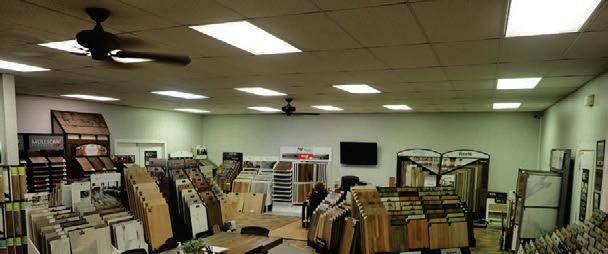

garden cont'd and are brought outdoors when temperatures exceed 50 degrees. “We do bring a few of them inside to enjoy with our guests when we entertain,” Stewart says.
Although each of the bonsai in their collection has a common name and a botanical name, occasionally one of the trees will earn a nickname — “for practical as well as poetic purposes,” Stewart says. There is one named The Duchess and another they call Nessy, because it looks to them like the Loch Ness monster.
The largest member of the collection is The Emperor. A lacebark elm whose trunk measures 58 inches around, The Emperor rises to a stately height of 47 inches. It is well over 100 years old. Just like its full-size relatives, The Emperor has exfoliating bark and diminutive leaves that turn golden yellow in the fall before dropping o . Because it requires a forklift to move the majestic tree, Stewart and Chilton build a greenhouse around it every year as winter approaches.
They hope that someday their collection will become part of a museum, where it might serve to educate and inspire others. “We build museums for art,” Stewart reasons, “why not an institution to house these trees, which are themselves living sculpture?”



You can hear the devotion in his voice when he talks about the bonsai they have collected and cared for over the years. Ask him which of the tiny trees he is most fond of, and he replies, “Every one of them is my favorite.”
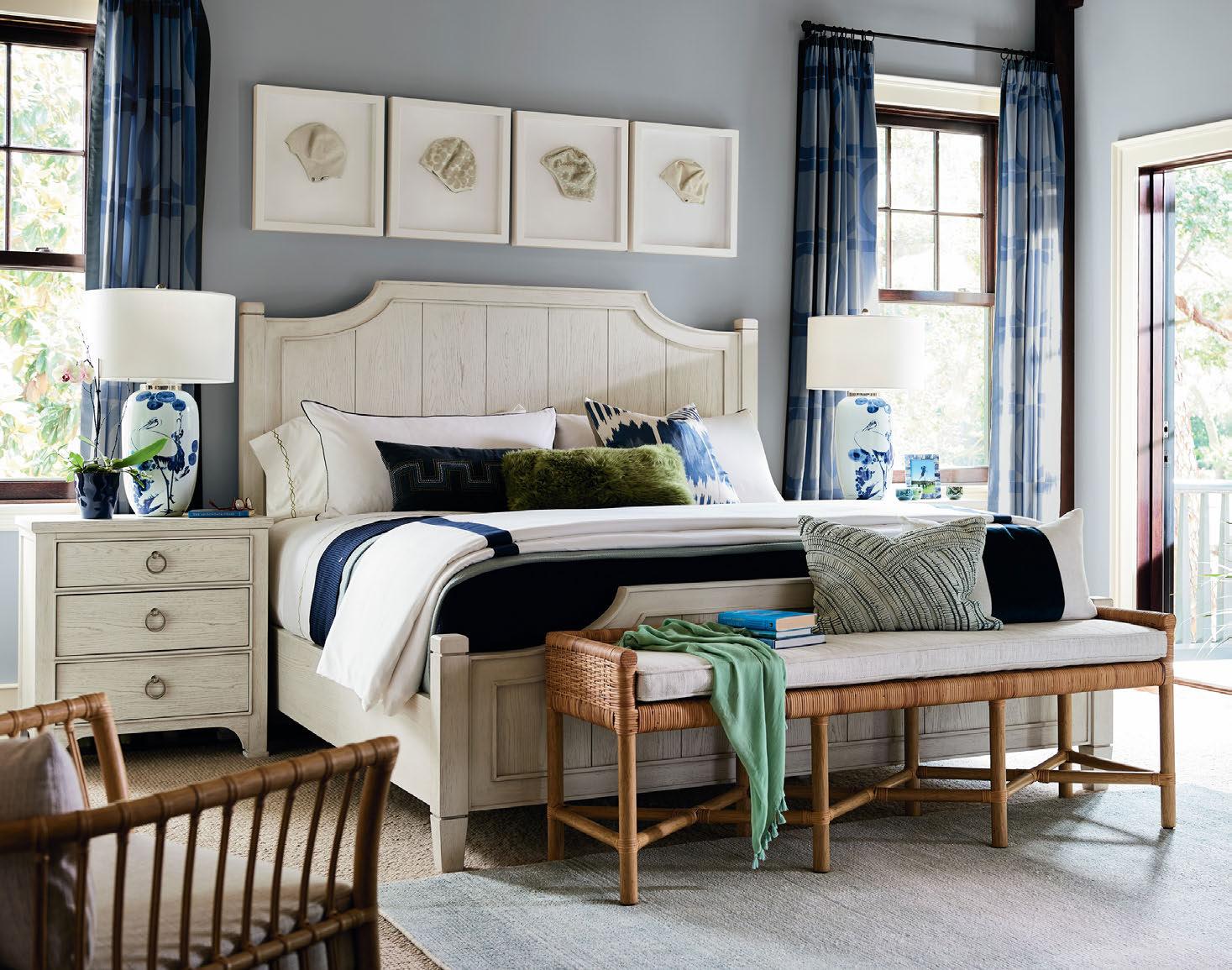
Immerse yourself in the essence of coastal living at The Shops at Carolina Furniture of Williamsburg. Our commitment to meticulous craftsmanship from the world’s most renowned manufacturers ensures that every detail exudes excellence. With guidance from our expert interior designers, discover the perfect pieces to infuse your home with seaside charm at 40%-60% o with our white-glove delivery service.
Part of a new breed of serious antique collectors and scholars, Michael S. Phillips found his calling amid his collections
By Cosima Pellis
Michael S. Phillips is a curator, a collector, a historian and an independent scholar, a true Renaissance man. His specialty is early-18th- and 19th-century American furniture and decorative arts, with a focus on pieces that are native to Virginia and Maryland. Influenced by classical Greek and Roman styles, he collects everything from Grecian-style sofas to ceramics and candlesticks hailing from Europe. Phillips is more than a collector; he has an eye for curation and the desire to share his passion with the community.
R•Home: How did you first become interested in collecting?
Michael S. Phillips: Ever since I was little, I’ve collected things, starting with Roman coins and smaller things. So I guess I’ve always had a collecting instinct. It was in school at the University of Virginia when I really got involved with American material culture and also became interested in antiquity, the ancient Greeks and Romans, and
the influence they had on early American art. After moving to Richmond, I started to go to lots of auctions, crawling under furniture, tipping things over, and started being able to identify pieces.
R•Home: What is your favorite piece in your personal collection?
Phillips: My favorite piece is probably a Richmondmade classical dining table with elegant, reeded legs with turned feet terminating in brass balls. I
would also say my Baltimore Hepplewhite shield back chair. I found it at an auction, late at night. The auctioneer said it was a reproduction, but I could tell that it wasn’t — I knew it was real. It’s an example of regional Baltimore furniture, a great period piece. This memory stands out because I had acquired the knowledge to know that it was real, but the other people at the auction didn’t know it. There’s a sense of euphoria when you realize that something’s really special and nobody else really knows.
R•Home: Could you elaborate a little bit more on your curatorial activities? Phillips: I really enjoy consulting with museums and private collectors. I have helped to curate quite a few exhibitions, including the first-ever exhibit of early Richmond furniture and material culture [shown at the John Marshall House in the spring of 2019]. The majority of
these pieces were from my own collection, because what’s the value of owning these objects if you can’t share them and their stories with the world?
R•Home: Do you have any tips for beginning collectors?
Phillips: You’re in the right place, with all of the art and architecture that’s so close at hand in Richmond. Go to museums and actually look at items that have provenance and are identified. Auctions are a great place to learn about art and furniture because you can actually touch and interact with the items, unlike in a museum. Connecting with actual physical items allows you to connect with the past. The more you see, the more you can get your hands on and inspect, the more you know. It can also be helpful to reach out to the community: There’s a great network of collectors, scholars and curators in Virginia.

















YOU CAN GET LOST IN the 600 postcards papering the walls of Scott and Lisa Hendrick’s powder room; it’s a truly immersive experience. Inspired by a fraction of the collection displayed elsewhere in the Hendricks’ home, decorator Erin Campbell sought to amplify the postcards’ impact by displaying them in a novel way — as wallpaper. When designing the arrangement of the cards, Campbell spent hours working on the creative puzzle to make sure the colors and objects depicted blend in a seamless rhythm throughout the room. The postcards, acquired on the Hendricks’ travels and from local shops Mongrel and World of Mirth, infuse the space with bits of Richmond, vacation destinations and creative flair. —Olympia Theofanos


VIRGINIA LIVING MAGAZINE BEST OF VIRGINIA WINNER BEST LANDSCAPING SERVICE

RICHMOND MAGAZINE’S R-HOME READER’S SURVEY MULTI-CATEGORY WINNER FOR LANDSCAPE DESIGN & MAINTENANCE HARDSCAPING, DECKING & FENCING MASONRY, IRONWORKS & DRIVEWAYS
RICHMOND MAGAZINE’S “BEST OF” BEST YARD MAINTENANCE
STYLE WEEKLY’S TOP 40 UNDER 40



